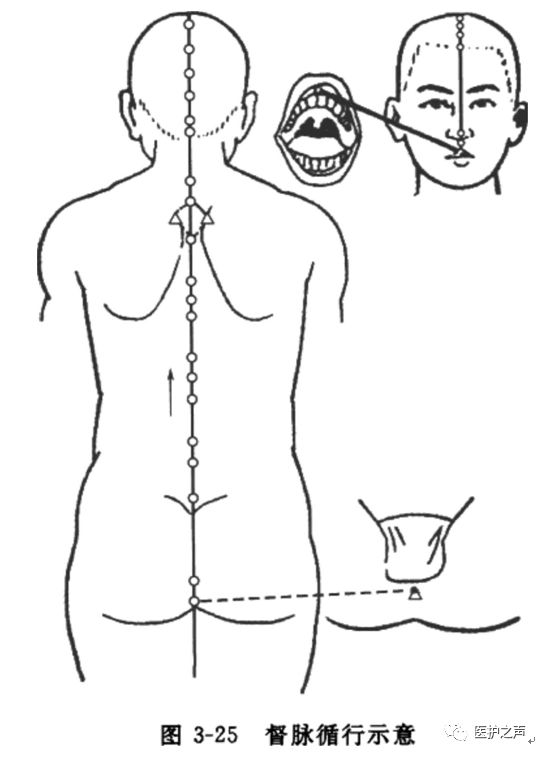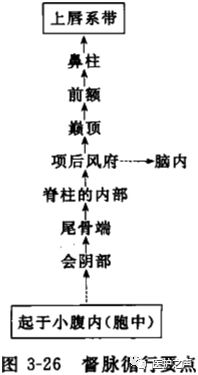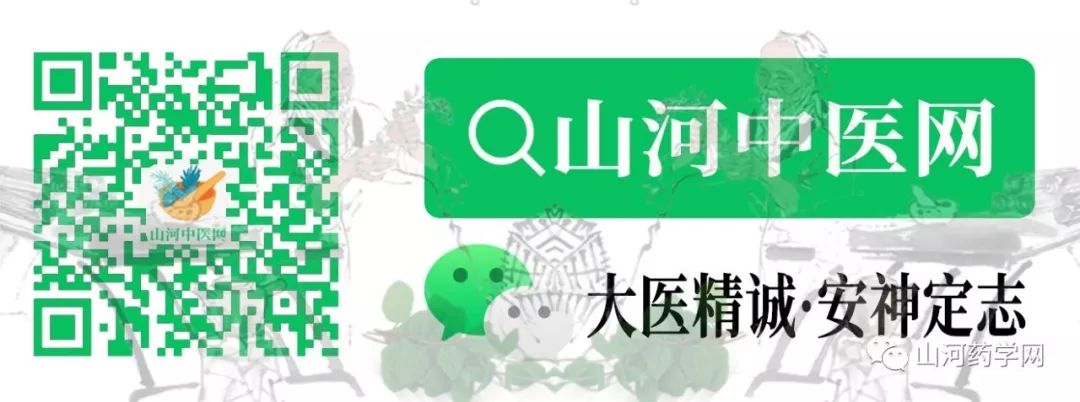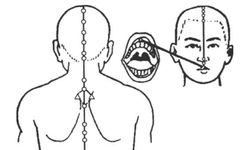The Eight Extraordinary Meridians
1. Governing Vessel
【Pathway】 “Nan Mai: Twenty-Eight Difficulties”: The Governing Vessel originates from the lower extreme of the Shu points, travels along the spine, ascends to the Fengfu (Wind Palace), and enters the brain. (It ascends to the vertex, follows the forehead, and reaches the nasal column)
Translation: The Governing Vessel starts from within the lower abdomen, exits at the perineum, travels posteriorly along the inside of the spine, ascends to the Fengfu at the back of the neck, enters the brain, ascends to the vertex, descends along the forehead to the nasal column, and terminates at the frenulum of the upper lip.
Note: The original text of “Nan Mai: Twenty-Eight Difficulties” only states, “The Governing Vessel originates from the lower extreme of the Shu points, travels along the spine, ascends to the Fengfu, and enters the brain.” The “Jia Yi Jing” cites this, adding “ascends to the vertex, follows the forehead, and reaches the nasal column.” See Figure 3-25.
Key points of the Governing Vessel pathway are shown in Figure 3-26.


【Key Points of the Meridians】 See Table 3-25.
Table 3-25 Key Points of the Governing Vessel Meridian
|
Associated Organs |
① Brain; ② Spinal Cord; ③ Kidneys; ④ Uterus |
|
Passes Through Organs |
① Nose; ② Eyes; ④ Lips; |
|
Main Symptoms |
Stiffness and pain in the spine, opisthotonos, etc. |
|
Summary of Indications |
1. Localized conditions of the lumbar, sacral, and cervical regions 2. Corresponding visceral diseases 3. Certain acupoints can treat mental disorders and febrile diseases |
【Acupoints of this Meridian】 Starts at Changqiang (Long Strong) and ends at Yinjiao (Gum Intersection), with a total of 28 acupoints, see Table 3-26.
Table 3-26 Acupoints of the Governing Vessel
|
Acupoint |
Specific Point |
Location |
Indications |
Needling and Moxibustion Method |
||
|
1.Changqiang |
Connecting Point |
At the tip of the coccyx, at the midpoint of the line connecting the coccyx and the anus |
Low back pain, hemorrhoids, epilepsy |
① Prolapse of the rectum, blood in stool ② Diarrhea, constipation |
Prone position, or chest-knee position |
Oblique insertion, needle tip directed upward parallel to the coccyx, insert 0.5-1 inch, do not penetrate the rectum to prevent infection, can apply moxibustion |
|
2.Yaoyangguan |
At the midline of the back, corresponding to the sacral hiatus |
① Irregular menstruation ② Lower limb paralysis |
Prone position |
Oblique insertion 0.5-1 inch; can apply moxibustion |
||
|
3.Xiayangguan |
At the depression below the spinous process of the 4th lumbar vertebra |
Low back pain |
① Lower limb weakness ② Irregular menstruation ③ Nocturnal emission, impotence |
|||
|
4.Mingmen |
At the depression below the spinous process of the 2nd lumbar vertebra |
① Enuresis, frequent urination, diarrhea ② Nocturnal emission, impotence ③ Vaginal discharge, irregular menstruation |
Perpendicular insertion 0.5-1 inch; can apply moxibustion |
|||
|
5.Xuanshu |
At the depression below the spinous process of the 1st lumbar vertebra |
Low back pain; epilepsy, gastrointestinal disorders such as vomiting and diarrhea |
Abdominal pain, undigested food |
|||
|
6.Jizhong |
At the depression below the spinous process of the 11th thoracic vertebra |
① Jaundice ② Hemorrhoids, rectal prolapse |
Prone or sitting position |
Oblique insertion 0.5-1 inch; can apply moxibustion |
||
|
7.Zhongshu |
Connecting Point |
At the depression below the spinous process of the 10th thoracic vertebra |
Jaundice, fullness, poor appetite |
|||
|
8.Jinsuo |
He-Sea Point |
At the depression below the spinous process of the 9th thoracic vertebra |
Stomach pain |
|||
|
9.Zhiyang |
At the depression below the spinous process of the 7th thoracic vertebra |
Cough, asthma, back pain, neck stiffness |
Jaundice, chest and flank distension |
|||
|
10.Lingtai |
At the depression below the spinous process of the 6th thoracic vertebra |
Healing sores, malaria |
||||
|
11.Shendao |
At the depression below the spinous process of the 5th thoracic vertebra |
Palpitations, forgetfulness, epilepsy |
||||
|
12.Shenzhu |
At the depression below the spinous process of the 3rd thoracic vertebra |
① Epilepsy ② Malaria |
||||
|
13.Taodao |
At the depression below the spinous process of the 1st thoracic vertebra |
Headache, febrile diseases, malaria, stiffness of the neck and spine |
Oblique insertion 0.5-1.2 inches; can apply moxibustion |
|||
|
14.Dazhui |
At the depression below the spinous process of the 7th cervical vertebra |
① Common cold, cough, asthma ② Night sweats ③ Epilepsy ④ Rubella |
Oblique insertion 0.5-1 inch; can apply moxibustion |
|
Acupoints |
Specific |
Location |
Indications |
Needling and Moxibustion Method |
|
|
Common Points |
Specific Points |
Position |
Operation |
||
|
15.Yamen |
At the midline of the back of the head, 0.5 inches above the 1st cervical vertebra |
Inability to speak |
Prone or sitting position |
Head slightly forward, neck muscles relaxed, slowly insert 0.5-1 inch downward, do not apply moxibustion |
|
|
16.Fengfu |
At the midline of the back of the head, 1 inch above the hairline, in the depression between the trapezius muscles |
Stroke |
Prone or sitting position |
Head slightly forward, neck muscles relaxed, slowly insert 0.5-1 inch downward. The needle tip should not be directed upward to avoid injury to the medulla oblongata, do not apply moxibustion |
|
|
17.Naohud |
2.5 inches above the hairline, 1.5 inches above Fengfu, in the depression above the external occipital protuberance |
Goiter |
Prone sitting position |
Horizontal insertion 0.5-1 inch; can apply moxibustion |
|
|
18.Qiangjian |
4 inches above the hairline |
Headache, neck stiffness, sudden loss of voice, epilepsy, dizziness |
Dizziness |
Sitting or prone position |
Horizontal insertion 0.5-0.8 inch; can apply moxibustion |
|
19.Houding |
5.5 inches above the hairline |
Dizziness |
Sitting or lying position |
Horizontal insertion 0.5-1 inch; can apply moxibustion |
|
|
20.Baihui |
5 inches above the hairline, or at the midpoint of the line connecting the tips of the ears |
① Insomnia, forgetfulness ② Stroke, hemiplegia ③ Diarrhea, dysentery, rectal prolapse, hemorrhoids, uterine prolapse ④ Syncope |
|||
|
21Qianting |
3.5 inches above the hairline |
Hemiplegia, red eyes, facial swelling, nasal congestion |
Sitting or supine position |
Horizontal insertion 0.5-0.8 inch; can apply moxibustion |
|
|
22.Xinhui |
2 inches above the hairline, 3 inches in front of Baihui |
① Stroke ② Nasal congestion, epistaxis |
Horizontal insertion 0.5-0.8 inch, do not needle children; can apply moxibustion |
||
|
23.Shangxing |
1 inch above the hairline |
① Eye pain, nasal congestion, epistaxis ② Febrile diseases, dysentery |
Supine or leaning sitting position |
Horizontal insertion 0.5-0.8 inch; can apply moxibustion |
|
|
24.Shenting |
0.5 inches above the hairline |
① Nasal congestion ② Palpitations, insomnia |
Horizontal insertion 0.3-0.8 inch; can apply moxibustion |
||
|
25.Suryao |
At the center of the tip of the nose |
① Nasal congestion, epistaxis, rosacea, asthma ② Convulsions, coma, neonatal asphyxia |
Oblique insertion 0.3-0.5 inch, or prick to bleed; do not apply moxibustion |
||
|
26.Shuigou |
At the upper third of the philtrum |
Epilepsy; mouth twitching |
① Stroke, coma, syncope ② Facial swelling, low back pain |
Oblique insertion 0.3-0.5 inch, or press with a fingernail, do not apply moxibustion |
|
|
27Duanduan |
At the tip of the upper lip, at the transition between the skin and the lip |
Gum swelling and pain, epistaxis |
Oblique insertion 0.2-0.3 inch; do not apply moxibustion |
||
|
28.Yinjiao |
At the junction of the upper lip frenulum and the upper gum |
① Gum swelling and pain, bad breath, mouth lock, gum bleeding, nasal congestion ② Lumbar sprain, neck stiffness ③ Hemorrhoids |
Oblique insertion 0.2-0.3 inch; do not apply moxibustion |
【Governing Vessel Acupoint Song】
At the tip of the coccyx is Changqiang, twenty-one vertebrae Yaoyangguan, sixteen Xiayangguan, fourteen Mingmen, thirteen Xuanshu at the center of the spine,
Eleven vertebrae below Zhongshu, ten vertebrae below the hidden center, nine vertebrae below Jinsuo, seven vertebrae below Zhiyang,
Six Lingtai, five Shendao, three Shenzhu, one Taodao below, one Dazhui above,
Up to the hairline Yamen, Fengfu one inch behind, Naohud two five above the occiput,
Four inches above the hairline Qiangjian, five inches five above Houding,
Seven inches Baihui at the top, at the center of the hairline,
Three and a half inches in front of Qianting, one foot Xinhui measured,
One foot one inch Shangxing, five points above the hairline Shenting,
At the tip of the nose Suryao, Shuigou below the nose,
At the tip of the upper lip Duanduan, Yinjiao at the gum seam.
Disclaimer: The content on this site is added and organized by users for learning and reference purposes only. The information on the site may not be accurate, comprehensive, or up-to-date, and the content should not be considered the final basis for diagnosing or treating diseases.Shanhe TCM Network reminds users that if you have any physical discomfort, please seek medical attention promptly. Thank you for your support and love; we will strive to do better~!!!


